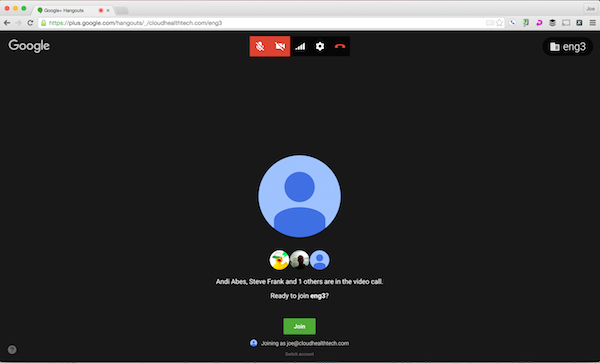I use Hangouts pervasively across my day, from hiring, to making phone calls, to engineering meetings, to talking with customers. My fondness for Hangouts is based on its elimination of the friction that comes standard web conferencing. With a single click I am in a meeting; two more clicks and I’ve pulled additional members of my team into the meeting; another couple clicks and we’ve dialed in one of our team members from his car. I like Hangouts so much that it pains me to go back to the circa 2004 conferencing tools that make scheduling and running web meetings feel like you work for the federal government.
While there are many features I wish Google Hangouts had, there is one that can be a deal breaker for me: the attendee limit. If you are a paying Google Apps customer, your limit is 15 participants; if not, it is 10. As my company has grown, we periodically have a need for Hangouts with more than 15 people.
Today I took a low tech approach to getting beyond the 15 person limit. While imperfect, it allowed me to not visit 2004 through the use of another conferencing tool. Here are the steps:
- As facilitator for the meeting, I provide attendees the option of two different Hangout links. Note: we’d followed Greg Arnette’s blog post a couple years ago to set up a series of persistent meeting rooms that can be used on-demand.
- I opened both Hangout links in a different browsers (Chrome and Safari) and placed them in separate monitors on my desktop.
- I shared the screen of my 1st monitor from the Hangout session running from my 2nd monitor, allowing all attendees of the 2nd Hangout to see the screen of the 1st Hangout session.
Simple right? Here are limitations:
- One way sharing - It’s only useful for sharing content one way. The users in the 2nd Hangout can see everything in the 1st Hangout, but not visa versa (although you can obviously workaround by manually sharing in reverse).
- Audio - Since the voice is bridged by the two browser clients, it is not high quality. One attendee today called it “less than stellar but functional.”
Okay, okay: I know I can always workaround this by clicking on my GoToMeeting icon, clicking on Schedule Meeting, giving the meeting a name / date / start / stop time, choosing how I want to manage audio, clicking Schedule, creating a new calendar invite in my calendar tool, copying / pasting the meeting invite into the calendar invite, and… (taking a breath)... well, you get the idea. ;)
Related posts: Migrating Between Two Google Apps Domains, 6 Months Without Microsoft Office
